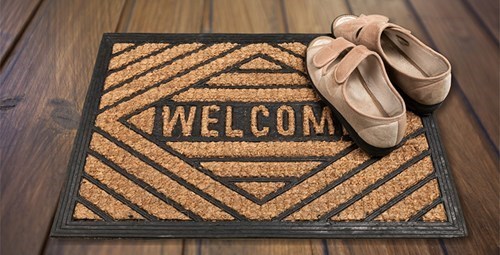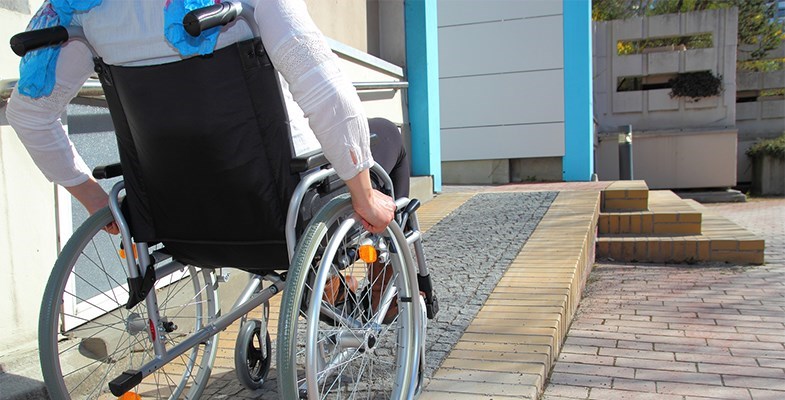Home should be the place where life gets easier. Instead, as we age or live with a disability, even little things can make everyday home life a frustration. When it gets harder to keep balance, a home can become an obstacle course. Poor vision or mobility can turn ordinary furnishings into an obstacle course. Gradually over time, little barriers put everyday tasks like making dinner or sitting in a favorite chair out of reach.
Living where and how we want is something many take for granted – until we can’t. For those who want to age in place or who can’t get in the door of a new apartment, home accessibility modifications help. This blog post offers some ideas that can make a big difference in a home’s livability.
Of course, along the way, we’ll show where to find these resources on the My Place CT website.
What are home accessibility modifications?
When you think about it, we all make little changes at home to improve livability, whether it’s moving the TV to where we can see it or arranging the furniture so we don’t trip over it. Home accessibility modifications go a step further to remove barriers or just make everyday life less of a struggle.
Some modifications are all about safety. Removing throw rugs to avoid slipping or adding grab bars in the bathroom help prevent accidents and falls. Other changes are about adjusting the home so it’s a more livable space. This could include adding ramps inside and outside, exchanging doorknobs for lever handles or making bigger changes in design like widening doorways to fit a wheelchair.
Gadgets and items that make living easier, but which are not part of the home structure or furnishing are often called assistive technology or adaptive technology. These can include a touch lamp beside the bed, an extendable grabber to pick up hard-to-reach items, or even voice-activated smart home technology.
Many important modifications don’t have to be expensive to be effective. Low-cost and no-cost steps include:
- Remove trip hazards and clutter – throw rugs are a big cause of falls
- Make sure you have good lighting, from bright light bulbs to positioning lamps in the right places
- Add night lights
- Check and fix railings on stairs and walkways
- Check the stairs – if stair runners can’t be secured, get rid of them. Or add non-slip grips
- Reorganize your stuff. The fewer things you need to reach for, the better. Rearrange items in the kitchen, bathroom and other spaces for easy access.
- Step away from the stepladder – are you able to reach all lightbulbs? Items in the refrigerator and kitchen shelves? Think about abandoning the shelves you can’t reach safely
Other modifications can cost more, but may be necessary. Later in this blog, we’ll talk about some of the programs available to help cover costs.
More complex modifications include:
- Modifying entryways and floors to provide a level, no-step surface
- Adjusting counters to a lower level, reachable from a wheelchair
- Getting an adjustable hospital bed or one with rails – also great for watching TV
- Switching to lever faucets that just need to be nudged
- Installing a roll-in or walk-in shower, with a sturdy seat
- Finding a chair that’s easy to get in and out of
For more ideas and suggestions, look on MyPlaceCT.org under Assistive technology and home modifications.
Why make home accessibility modifications?

Think of home modifications as part of the life and usability of a living space over time. Chances are, needs will change. If you are planning renovations today, it may make sense to adjust for tomorrow’s needs at the same time to support aging in place.
Planning for accessibility modifications should accommodate visitors. Think of the home as a place that’s welcoming to friends and family of all ages and abilities, whether they are aging parents or a friend who has difficulty walking. This is called “visitability.” Other modifications can make it easier for family members or paid caregivers to provide help.
Home modifications can help with:
- Preventing falls
- Getting in and out of the house
- Bathing and other help in the bathroom
- Making room for a walker or wheelchair
- Getting in or out of bed
- Cooking meals and eating
- Storing things in reach
- Getting up or down stairs
- Turning lights on and off
Form and function
Changing a home can make practical sense, but sometimes it also takes some getting used to. As part of her work in gerontology for a national insurance company, Maureen Mohyde conducted focus groups with older adults to learn about home modifications. Surprisingly, the people she studied were not always enthusiastic about making changes, even when they needed them. When Maureen started using a wheelchair herself, she soon learned firsthand what the research participants were saying.
The research showed that many people avoid home modifications because they are an obvious “tell” for old age or a disability. Research participants reacted negatively to designs that smack of a hospital. However, when an accessibility modification or technology is positioned as something everyone would use or marketed as convenience, and then then it’s something you choose, not something you’re forced into. Designers refer to this as universal design.
The example she gave was the way people react badly to the look of raised toilets. But when Kohler marketed their elevated toilet as “comfort height,” then people embraced it. The same happened when marketers repositioned adjustable beds or garage door openers as great conveniences.
“Visitability is huge,” Mohyde notes. “This is the idea that even people without mobility concerns may want their home to be welcoming for their parents or a friend with a disability. “The world is not as accessible as it claims to be,” she continues. Reduced ability to come and go can make a home more isolated – or friends’ homes off limits.
She uses her portable ramps both as a way to enjoy her deck and move about uneven floors in her house, but also as a way to visit friends or places with steps.
Gadgets are getting better, cheaper. She said that her smart home device opened up her ability to do things for herself. Because she does not have us of her hands, she uses the smart speaker to play the radio, listen to podcasts and turn lights on and off. These devices now do so much more, including, making calls, adjusting the room temperature or using a security camera to see visitors at the door and let them in or not. She also likes the cool factor, “everyone loves gadgets,” and they’re not complicated and now not all are expensive.
Get help with choices
With so many choices, it can be hard to decide what works for you. That’s when it’s best to go to a professional who knows how to solve specific problems. Or, if you are on a program like Medicaid, you may need to get a professional diagnosis and treatment plan to meet program guidelines.
Either way, going to a professional is a good place to start. Here’s a review of the kinds of services different people offer. You can find specialists and more information at MyPlaceCT.org under Assistive technology and home modifications.
Almost every program that offers or provides funding for home / environmental accessibility modifications has specific requirements for an on-site assessment of the current situation and recommendations to make the home more accessible. Typically these are done by Physical Therapist (PT) or Occupational Therapists (OT) and would likely be covered by your insurance. Specific requirements vary from program to program and should be available from the program or in the application.
Occupational therapist (OT)
Advises on personal living and safety needs for people of all ages. They help people who have physical, mental, developmental, social or emotional conditions to develop skills or adaptations to support daily living. They can do an assessment and recommend assistive technology or home accessibility modifications to make life simpler and safer.
Physical therapist (PT)
Diagnose and treat people of all ages and abilities to maintain or recover movement and ability from injuries or health conditions. They can do a home safety evaluation and assess what accessibility modifications or assistive technology will help people remain in their homes or transition from a nursing home to their own place in the community.
If home modifications are needed, a physical therapist will recommend needed modifications and also list specifications like how wide doors need to be, where grab bars need to go and how ramps need to be built. When you need an assessment to qualify for state support, do not use a physical therapist who works for your contractor. They need to be independent.
Certified Aging in Place Specialist (CAPS)
These are usually remodelers, but can also be architects, designers or even health care specialists. They have special training and certification to create barrier-free homes. They can specify products (like raised toilets, grab bars, etc.), and can provide an estimate of costs.
Professional care managers
People who receive care management as part of state services and programs, such as Money Follows the Person or the Connecticut Home Care Program for Elders can learn about home modifications from the care manager assigned to them. People who are not on state programs may also hire their own care managers who can advise on ways to make living spaces work better.
Programs that help
Fortunately, there are many programs, grants and resources to help. The trick is to find the ones that match specific needs or situations. Some are only for people with disabilities. Others are for older adults. There are programs just for veterans. Or people with spinal cord injuries. Some assistance is part of Medicaid or state or federal programs.
The first place to search is MyPlaceCT.org for a more complete list of programs to pay for assistive technology and home modifications. This explains the type of help available and who it’s for, then links to organizations and application forms.
The listings on CT 2-1-1 will help with finding services.
Another good starting place is Connecticut’s United Way 2-1-1 website. Type “home barrier evaluation/removal services” and your location under “I’m looking for.”
The rewards of planning
Anyone who has started home improvement projects – even small ones – quickly finds that if you’re not careful, little projects become big ones. The key is planning. Working with professionals to assess needs and recommend home accessibility modifications can save money in the long run.
The rewards for an accessible home will be a living space that supports your life and welcomes loved ones.





